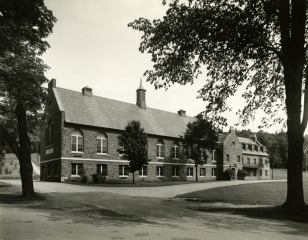Sciences, and University Studies (embracing the core courses). Each was administered by a Director, subordinate to the Dean of the Faculty, for whom the five directors served as an advisory group.
Under Mr. Case the role of faculty as a deliberative body for discussing and deciding academic affairs was revived. Instead of meeting regularly only three times each year, as had been customary in the ’30’s, the faculty convened once a month. As a kind of “academic senate” there was the Educational Policy Committee which was set up in 1947 following the discharge of the Committee on the Post-War College after its report had been adopted. The membership included the President as chairman, the deans and some other administrative officers, and division directors, all ex officio, and elected faculty members who constituted the majority. Two ad hoc faculty committees, one on the Humanities and the Self-Study Committee, conducted extensive investigations of the curriculum and its possible revisions and of the efficiency of administrative and instructional procedures and made several recommendations, some of which were implemented. Likewise, four separate visiting committees of outside experts, invited to the campus in 1958, and 1960-’62, to examine the work of the Divisions, made helpful suggestions for improvements.
Closer relations between the faculty and Board of Trustees were promoted by the Faculty Conference Committee, first appointed in 1954 as a Liaison Committee, to consult with the Trustee Committee on Academic Affairs. It was useful in supplementing the President’s presentation to the full Board of faculty views and needs.
The faculty’s economic and organizational status improved greatly under Mr. Case’s administration. By 1960-61, the average salary for full-time members in all ranks reached more than $9,000. Fringe benefits, in addition, included the annuity and group insurance programs and payments of medical insurance premiums. In 1959 it was possible to revive the program of sabbatical leaves which had been in abeyance since 1929. Six months with full salary or a year on half salary was arranged to enable professors to travel, carry on research, and restore some of the energy expended over the preceding six years. Growing out of Post-War Committee discussions came a statement on academic freedom,tenure, and promotions adopted by Trustees and faculty in 1948-49.
Out of faculty and community discussions of the problems of the







